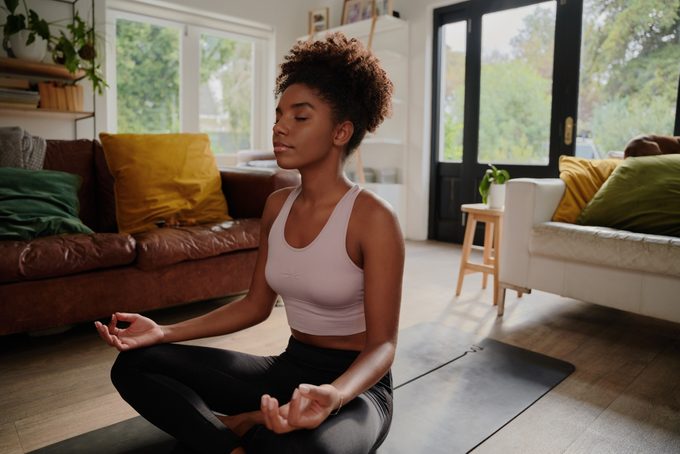Don’t Fall for These 10 Meditation Myths
Updated: Jun. 09, 2021
Don't let these meditation myths keep you from getting zen. Here's the truth, according to meditation pros.
Our editors and experts handpick every product we feature. We may earn a commission from your purchases.
Meditation basics
You’re ready to start meditating. Consider yourself in good company.
A National Health Interview Survey (NHIS) report found that adult meditation tripled between 2012 and 2017. It’s estimated to be even more prevalent now, thanks to a global pandemic that left a lot of people stressed, anxious, and in search of inner calm.
The potential benefits of meditation are certainly alluring: lowered stress, anxiety, depression, and pain among them.
So you want in. You’ve already read all the meditation tips, but somehow you still can’t seem to start a practice.
Maybe that’s because, like many people, you still hold some preconceived notions about meditation or falsely believe some persistent meditation myths.
Experts say not to let these stop you from starting or continuing a practice.
If you want to meditate, here’s what you need to know about the most common meditation myths—and why they are inaccurate.
Myth: Thoughts during meditation is bad
The most common myth about meditation is that you’re not supposed to have thoughts while you’re meditating, according to Josephine Atluri, a meditation coach and teacher in Los Angeles.
“I think that this myth got perpetuated because oftentimes you hear people saying that you’re supposed to clear your mind of anything to be in the present moment and to gain clarity and nirvana,” she says. “And that’s just not the case because the truth is we have between 60,000 to 80,000 thoughts a day.”
The idea of completely turning off thoughts is unrealistic, even for the most seasoned meditation practitioners and teachers. It’s an intimidating concept to think you must turn off thoughts entirely.
After all, even the thought of not thinking is still a thought, points out Dora Kamau, a meditation and mindfulness teacher in Vancouver, Canada.
The true goal is to achieve stillness and silence while sitting in meditation. Then, when a thought does come in, you acknowledge it without judgment and send the thought away.
What exactly does that mean? Well, it depends on the person.
Atluri says that might look like silently speaking to the thought, saying something like, “I’ll get back to you later.” Or you might visualize yourself putting the thought on a cloud and pushing it away. Go with whatever works for you.
(Get inspired with these mindfulness quotes.)
Myth: Meditation should come naturally
Tatyana Souza, a yoga and meditation teacher and owner of Coolidge Yoga in Brookline, Massachusetts, says not only is the idea of completely clearing your mind a myth but it also breeds other myths.
You might think that some people have an innate capacity for mind-clearing, or that the skill should be natural, not learned.
“This concept in practice is truthfully quite difficult, and that is why it is called a meditation ‘practice,'” she says. “This often leads to many people quitting after their first try or even after their first minute of attempting to meditate.”
In fact, being “good” at meditating, in general, is all relative. You don’t need to be “good” at meditating to try it or get the benefits of the practice.
People often swing to one side of the pendulum or the other, thinking that meditation is either very easy or very hard.
But Kamau notes that meditation is a practice, something to cultivate over time with consistency and discipline. That’s why it’s important to form a daily meditation habit.
“It’s similar to training our muscles. We’re training the mind with repetition and practice,” she says.
It may come easier to some than others, but you don’t have to be a certain type of person to achieve a meditative mindset, Kamau says.
Myth: Meditation has a lot of rules
A common meditation myth centers on the idea that there are rules to meditating, or that there is a right way to do it, says Matthew Ferry, a spiritual teacher, happiness coach, and author of Quiet Mind Epic Life.
“New meditators feel like they must follow the structure, system, or process laid out by the teacher, or the method, to do it right,” he says. “Meditation is more art than science.”
It’s more intuitive than mechanistic, he adds, saying there is no right way or wrong way to meditate.
The attachment to spiritual goals, like inner peace, also creates confusion for those new to meditation. “The mind becomes fearful that something is wrong when the lofty goals aren’t instantly attainable,” Ferry says.
The truth is there are no rules to meditation. That’s why there are so many different types of meditation.
Myth: You need to meditate for a certain amount of time
Stories of Buddhist monks and gurus who meditate for hours on end sound great, but for most people, it’s hard to imagine sitting in stillness and silence for 30 minutes, never mind hours.
“We also hear actual, factual scientific studies that show that doing meditation can change the structure of the brain, but that needs to be done for at least 20 minutes a day every day,” Atluri says. “And while that is true as proven in those scientific studies, one can still receive benefits from meditation simply by doing it for two to three minutes.”
So how long should you meditate? Reassuringly, longer isn’t necessarily better.
Even short meditations offer benefits, like creating the habit of calming yourself down.
“In overwhelming and stressful situations, you’re better able to utilize that strategy that you practiced in your two- to three-minute meditation than had you not been practicing before,” she says.
The reality is that many people are too busy to dedicate long spans of time to meditation. And that means they just don’t do it. It’s better to do shorter bouts—say, five or 10 minutes—if it means you’ll actually meditate.
The key is finding a length that works for you, even if your practice is more like mini-meditation sessions. Any amount of time could work. Get started by giving this quick 5-minute meditation a try.

Myth: You need to sit with your eyes closed and breathe a certain way
Taking a stroll and intentionally focusing on your thoughts and feelings is just as valid as sitting with your eyes closed during meditation, Ferry says.
And while it can be beneficial to focus on your breathing, there is no particular pattern that is better or worse than any other.
“The actual objective is to turn your attention inward,” Ferry says. “That can be accomplished by putting your attention on any aspect of your physiology.”
Myth: You have to use special equipment
All the best things in life are free, including meditation. And although there are accessories that may make meditation more fun or comfortable, they are window dressings.
All you really need is a quiet and comfortable space.
“You’ll see pictures of people with statues, candles, incense, yoga mat, yoga pillows, but the truth is you don’t need any of that,” Atluri says.
(Shopping for meditation gifts? Check these out.)
Myth: You can meditate only in certain places
Meditation can be done anywhere, Atluri says. So in addition to not needing meditation accessories, you also don’t need to be in a class or certain room to practice either.
In fact, Atluri practices meditation while brushing her teeth. You can meditate in the car or anywhere (and anytime) you may be able to turn it into a habit.
“It’s best to establish a routine for where you’re going to be [meditating] because then you’ll start to associate that place with this new practice that you’re trying to build,” Atluri says.
You might even want to try squeezing it in before bed since lying down to meditate can prepare you for better sleep.
Myth: Meditation is always the same
Meditation is like working out, according to Ferry. Each time you do it, the experience will be a bit different.
“You are in a different place physically, mentally, and emotionally,” he says. “Your meditation experience will be a representation of where you are in the moment. Which happens to be never the same.”
(Here’s what to know about RAIN meditation and if you should try it.)
Myth: Meditation will always feel good
The body tends to ignore negative emotions so that you can keep moving forward in life. However, meditation allows those negative thoughts and feelings to become present and be released, which is uncomfortable for the beginner, Ferry says.
“We are sold on the idea that we will feel peace when, in fact, meditation is often a negative emotional release,” he says.
Achieving a positive inner state of well-being is not straightforward. And inner peace is a lofty goal because the body and mind are unpredictable and difficult to influence.
“Meditation is a challenge and should be treated as such—the same way you might treat a new workout commitment,” Ferry says. “It’s tough in the beginning. It’s exciting when you get momentum. You will plateau. You will want to quit. Life will get in the way. So too with meditation.”
The purpose of meditation is not to be in a place of pure joy the entire time but rather to learn to give yourself care and attention, notes California-based meditation mindfulness teacher Laura Linn Knight.
“In the quiet, I become aware of [the] pain in my body, worries that I have been trying to avoid, and upsetting feelings,” she says.
Instead of avoiding the negative entirely, meditation allows you a space to feel them and release them.
(Try these mini meditations to relieve stress.)
Myth: Sitting in silence is the best way to meditate
The idea of sitting in silence during meditation can intimidate beginners. Although it’s good to limit distractions, Atluri says you don’t need to sit in complete silence the entire time. That’s just another meditation myth.
“Nowadays, we have the benefits of having so many apps and so many teachers who provide online free courses, such as myself,” Atluri says. “So meditation doesn’t have to just be a silent practice where you’re sitting there trying to follow your breath by yourself.”
She advises new meditators to try a meditation app, class, or teacher, for initial guidance.
These resources make meditating easier, more motivating, and much less intimidating. If you’re not exactly sure how to meditate, check out our beginner’s guide to meditation.
There are also free meditation sources you can use to help you get started.
Now that you know about these meditation myths, here are 10 ways to sneak meditation into your daily life.



